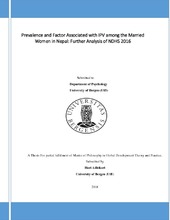Prevalence and Factor Associated with IPV among the Married Women in Nepal: Further Analysis of NDHS 2016
Master thesis
Permanent lenke
https://hdl.handle.net/1956/18904Utgivelsesdato
2018-12-18Metadata
Vis full innførselSamlinger
Sammendrag
Introduction: Intimate Partner Violence (IPV) is a predominant form of violence against women around the world. One in third women experience IPV globally and almost 38% of women in South Asia experience it. In Nepal, one in four women experience violence from their husband. Even though IPV leads to physical, mental, psychological and economic losses; the problem persists in most part of the country. To prevent it, an impulse research is needed that explores the prevalence and figures out the associated factor with it. This research attempts to find the prevalence and factor associated with IPV among the married women in Nepal at individual, relational and societal level. Methodology: This quantitative research is based on the secondary data of NDHS (2016). This study includes 4,444 married women of reproductive age group of Nepal. It applies SPSS tools to find out the results. Mainly, Cross-tabulation including Chi-square test and Binary logistic regression analysis were methodological tools to explore the result. Result: The research revealed that 26% women experience at least one form of IPV. Among them, 23.8% of women experienced less severe physical IPV, 9.9% experienced severe physical IPV, 7.9% experienced sexual IPV and 12.7% experienced emotional IPV. The factor associated with IPV were education, religion, ethnicity, wealth index, husband drinking alcohol, exposure to the parental violence and acceptance of beating. Conclusion: IPV is still a prominent problem in Nepal. To prevent it, the governing body and legal authorities must cover the associated factors of IPV that were studied in this study.
